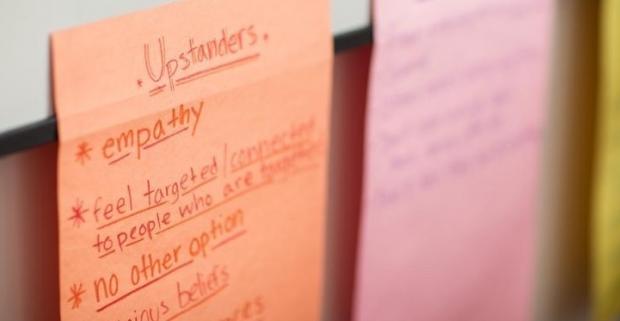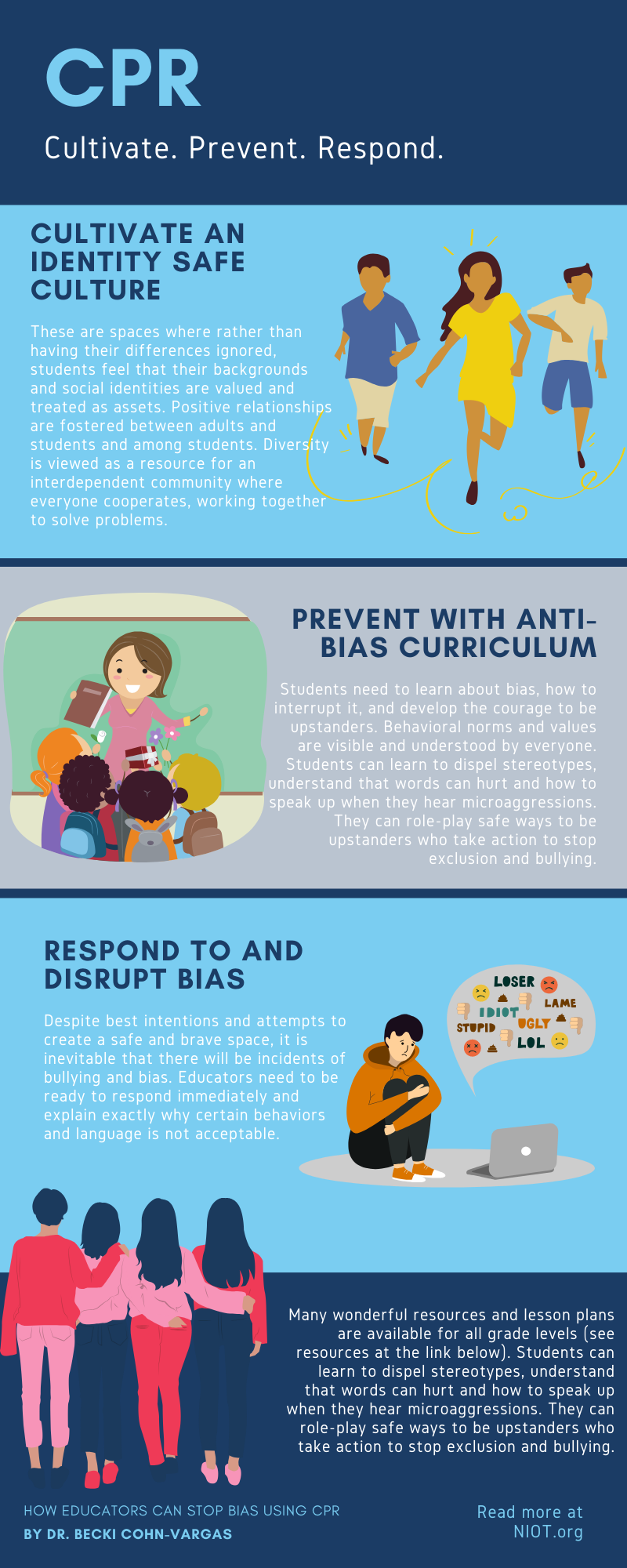 |
|
Image courtesy of Facing History
|
On January 23, 2020, the San Francisco Contemporary Jewish Museum (CJM) sponsored an evening for educators entitled: Upstanders Teacher Mini-Summit: Disrupting Bias and Building a Positive School Culture. CJM hosts Cara Buchalter and Fraidy Aber opened the evening with Samantha Brown of the Anti-Defamation League. Presenters included Dr. Becki Cohn-Vargas, former NIOS Director, Rick O’Culto, Education Coordinator, Our Family Coalition, and Pepe Gonzales, Principal of Laurel Dell Elementary School in San Rafael.
Dr. Cohn-Vargas shared an acronym, CPR (Cultivate, Prevent, Respond), highlighting the urgency of creating safe and brave spaces while disrupting all forms of bias in schools. We asked Becki to share her thoughts about the evening and introduce the power of CPR.
By Dr. Becki Cohn-Vargas
What is an upstander? An upstander is a person who speaks up and stands up for themselves and others to stop harm from taking place. As educators, it is imperative that we act as upstanders for our students, for our colleagues, and for our communities because by speaking up we are not only in the position to interrupt bias, we can also teach others how to be upstanders themselves.
I coined the acronym CPR to emphasize that educators are literally saving lives!
I began the evening sharing the story of my personal experiences being called a dirty Jew as a child. While it hurt deeply, I never breathed a word of it to anyone at the time. I shared this because I wanted participants to understand the vulnerability of children and how bias and hurtful words can influence a person for a lifetime.
I also shared stories from my mother’s youth in Hitler’s Germany. I described the insidious way that bias steadily grew, beginning with moments of exclusion from her school’s Nazi rallies, to being thrown out of her school, and to having to flee her home country for her life with her parents. I brought up recent anti-Semitic hate incidents, including how last summer, a man a few miles from my home constructed a huge swastika on his lawn.
I wanted to describe the frightening way hate can escalate. I also shared some alarming statistics on growing anti-Semitism, the increase in bias of all kinds at schools, and a sobering statistic that in 9 out of 10 cases, school leaders and teacher do nothing*. I wanted to emphasize the urgency of interrupting all forms of bias, especially now, in a time in which acts of hate have been increasing.
Hence, CPR. The acronym stands for the following three crucial elements for addressing bias and teaching our students to be upstanders.
C: Cultivate an Identity Safe Culture
P: Prevent with Anti-bias Curriculum
R: Respond to and disrupt bias
C: Cultivate an Identity Safe Culture: These are spaces where rather than having their differences ignored, students feel that their backgrounds and social identities are valued and treated as assets. Positive relationships are fostered between adults and students and among students. Diversity is viewed as a resource for an interdependent community where everyone cooperates, working together to solve problems. Students are taught to think for themselves and reflect on their identities. They learn effective communication skills and strategies for respectfully resolving conflicts. Expectations for all students are high and they are supported emotionally and academically to reach their potential.
P: Prevent with Anti-bias Curriculum: Besides creating an identity safe space where all students feel belonging, students need to learn about bias, how to interrupt it, and how to develop the courage to be upstanders. Behavioral norms and values are visible and understood by everyone. Many wonderful resources and lesson plans are available for all grade levels (see resources below). Students can learn to dispel stereotypes, understand that words can hurt and how to speak up when they hear microaggressions. They can role-play safe ways to be upstanders who take action to stop exclusion and bullying.
R: Respond to and Disrupt Bias: Despite best intentions and attempts to create a safe and brave space, it is inevitable that there will be incidents of bullying and bias. Educators need to be ready to respond immediately and explain exactly why certain behaviors and language is not acceptable. Care is taken to stop further humiliation of targets and they are supported to stand up for themselves in the future. Those who bully and harm others can learn from their mistakes and change their behavior. Bystanders need to see how they could have spoken up and learn how to do so in the future. If something happens, even in the middle of the lesson, educators can stop everything, explaining that this behavior is harmful. They can always return at a later time to go deeper.
At the mini-summit, two other presenters also shared stories from their lives, presenting ways to disrupt bias and build a positive culture. Rick O’Culto shared his experiences and highlighted the need for educators to take risks and also teach courage to their students. He also discussed the importance of students seeing themselves reflected in the curriculum, highlighting examples of schools who have integrated the history and contributions of LGBTQ people. Principal Pepe Gonzales talked about ways to create a welcoming community where everyone belongs, offering examples from his school. Participants were asked to offer examples of CPR on post-it notes which were placed on trees as we asked them to share their ideas.
The entire evening was a call to action for educators, a call for urgency, for bravery, and for hope as we undertake the mission of CPR in our classrooms and schools.
 |
Books/Action Guides:
Whistling Vivaldi and Other Clues to How Stereotypes Affect Us by Claude Steele
Identity Safe Classrooms: Places to Belong & Learn by Dorothy Steele and Becki Cohn-Vargas
Culturally Responsive Teaching & the Brain by Zaretta Hammond
NIOS Take a Stand in Your School Action Kit
Teaching from the Bull’s Eye: Protecting Your School from Hate and Harassment
Coming August 2020:
Identity Safe Classrooms Grades 6-12: Places to Belong and Learn Becki Cohn-Vargas with Alexandrea Kahn and Amy Epstein
Lesson Plan, Videos, Websites:
Mix It Up at Lunch: Tolerance.org
Upstander Design Challenge
US vs Hate Messaging Project, Lesson plans: USvsHate.org
No Place for Hate: ADL.org
No Name-Calling Week: GLSEN.org
Not In Our School Videos, Lesson plans
Genderspectrum.org
Ourfamily.org